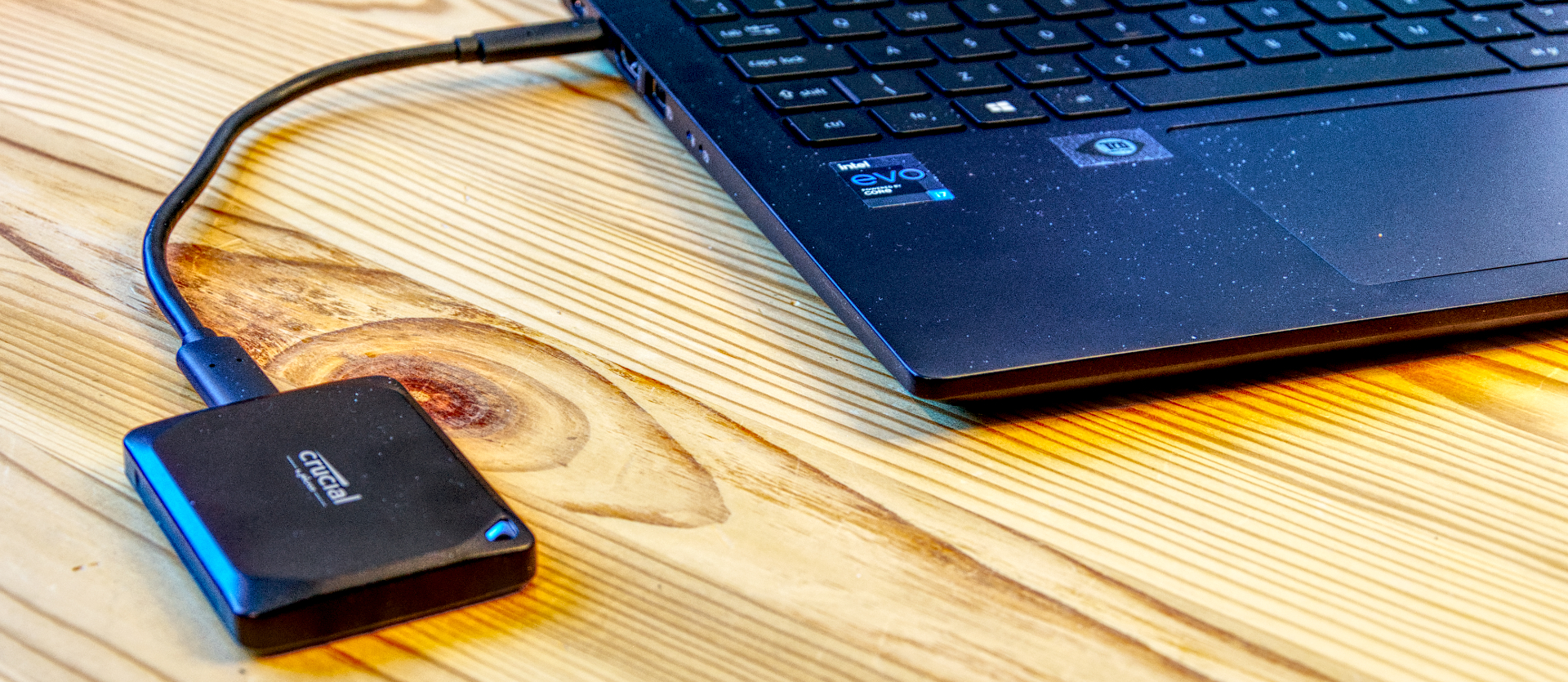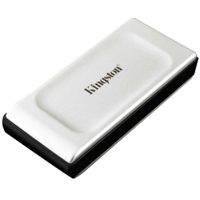TechRadar Verdict
A new flagship design of the Crucial X-series, the X10 Pro brings security, resilience and performance improvements at a price. The buying public might well conclude that the X8 and X6 are great drives at a tempting price, and the X10 Pro looks overpriced alongside them.
Pros
- +
USB 3.2 Gen 2x2 support
- +
1TB, 2TB or 4TB options
- +
Hardware encryption
- +
Tough and compact
Cons
- -
Overpriced
- -
No USB-A cable adapter
Why you can trust TechRadar
One-minute review
Crucial has had two of the most popular external SSDs in the X8 and X6, making up the X-Series external SSDs. Their success was due to solid engineering, excellent specification, and competitive pricing.
Now Crucial aims to repeat that recipe with the X9 Pro and X10 Pro, offering even better build quality, enhanced features such as hardware encryption and support for USB 3.2 Gen 2x2 in the X10 Pro.
As the flagship of the X series, the X10 Pro is the natural replacement for the X8, providing the same 1TB, 2TB and 4TB capacities while potentially delivering 2000MB/s transfers, double that of its predecessor.
So what is the catch? When compared to the X6 and X8, it’s the price. For exactly the same capacity, the X10 Pro is roughly 80% more than the X8.
That’s a stark differential if you don’t have USB 3.2 Gen 2x2 or use hardware encryption, and many customers will vote with their wallets. That high pricing isn’t exclusive to the USA either, as in other regions, the X10 Pro can be even less competitive.
To cut to the chase, the X10 Pro is well-made and designed, and one of the fastest external SSDs, performing impressively well when connected to the correct type of USB interface, but the pricing is unrealistic, and we’d recommend you get an X8 or X6 instead.
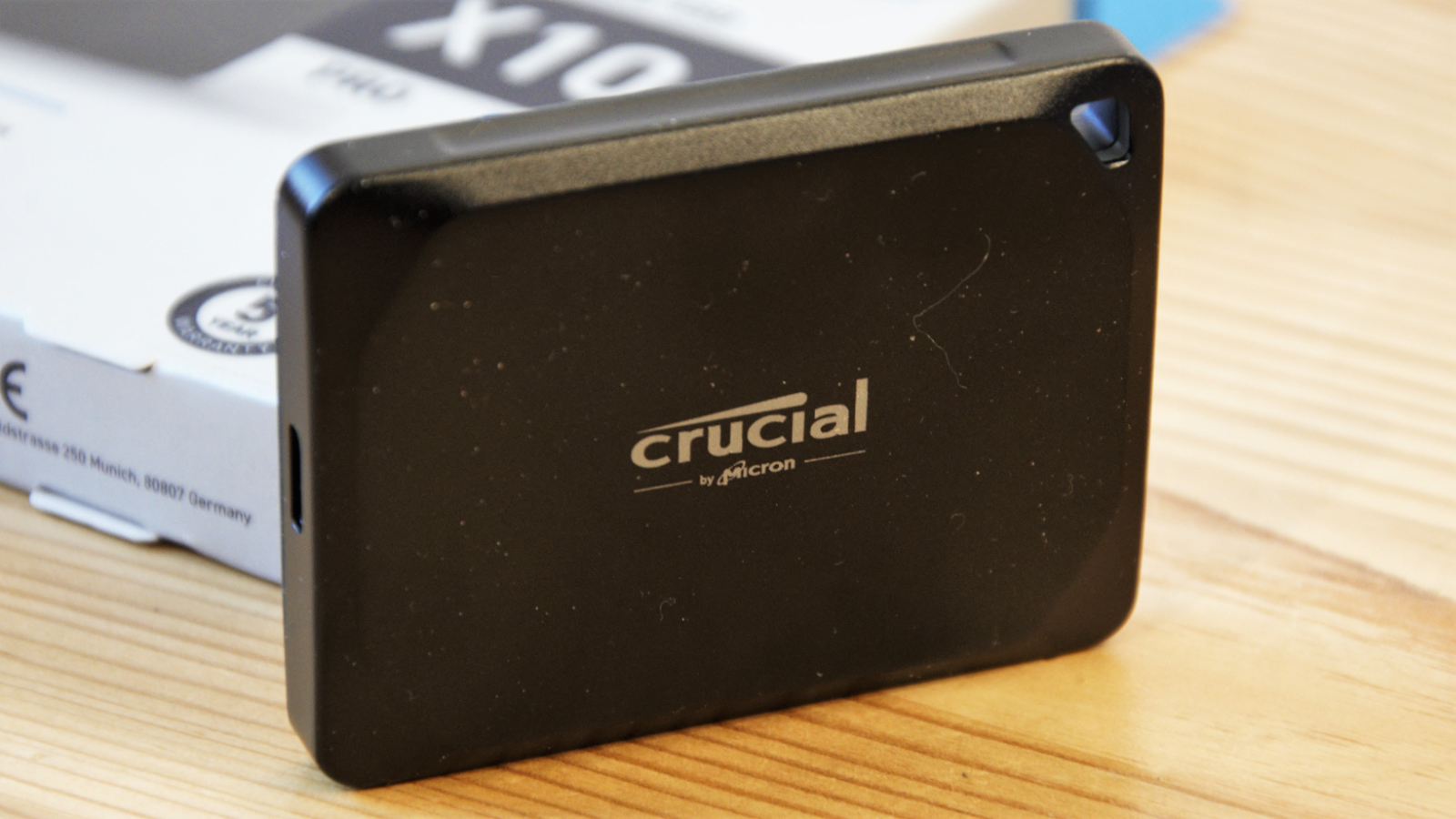
Crucial X10 Pro: Pricing and availability
- How much does it cost? $119.99/124.79/€149.26
- When is it out? It is starting to be available now
- Where can you get it? Direct from Crucial or through online retailers like Amazon.
When the X9 Pro and X10 Pro launched in August, US prices were $119.99 (1TB), $169.99 (2TB) and $289.99 (4TB), and these remain at those levels directly from Crucial at the time of writing.
However, UK and European launch pricing was much higher, up to 40% more than the US prices at the current exchange rate.
The UK official pricing direct from Crucial is £124.79 (1TB), £230.39 (2TB), £383.99 (4TB), and in the EU, the Euro prices are €149.26 (1TB), €270.64 (2TB), €447.95 (4TB).
The only positive news we can spread is that in the UK, some retailers are involved in a promotional deal until the 30th of September 2023, offering the X10 Pro at £107.99 (1TB), £194.99 (2TB) and £357.99 (4TB). These deals are at Ebuyer, Box, CCL and Amazon. But we don’t expect these reductions to stick over the offer period.
Irrespective of geographic location, the previous Crucial X8 and X6 designs are considerably cheaper if you only want a specific capacity and don’t care about Gen 2x2 or hardware encryption.
For those that specifically want Gen 2x2 performance, the choices are the Corsair EX100U, Kingston XS2000, SanDisk Extreme PRO V2, ADATA Elite SE880 and the Sabrent Rocket Nano.
At 1TB capacity, the Crucial X10 is the most expensive, the same price as the SanDisk Extreme PRO V2. At 2TB, it’s cheaper than the Kingston XS2000 and SanDisk Extreme PRO V2 in the USA, and in Europe, it’s the most expensive.
And finally, at 4TB, it is one of the cheaper drives for US customers but the most expensive for UK and EU buyers.
I'm not sure if the US prices of the X10 Pro can be justified for this drive, but for Europeans, they can’t be rationalised.
It may be that Crucial is attempting to throttle demand outside of the USA while they ramp up production, but as a result, they will convince those customers in Europe that the X9 Pro and X10 Pro aren’t great value like their predecessors.
- Value: 3 / 5
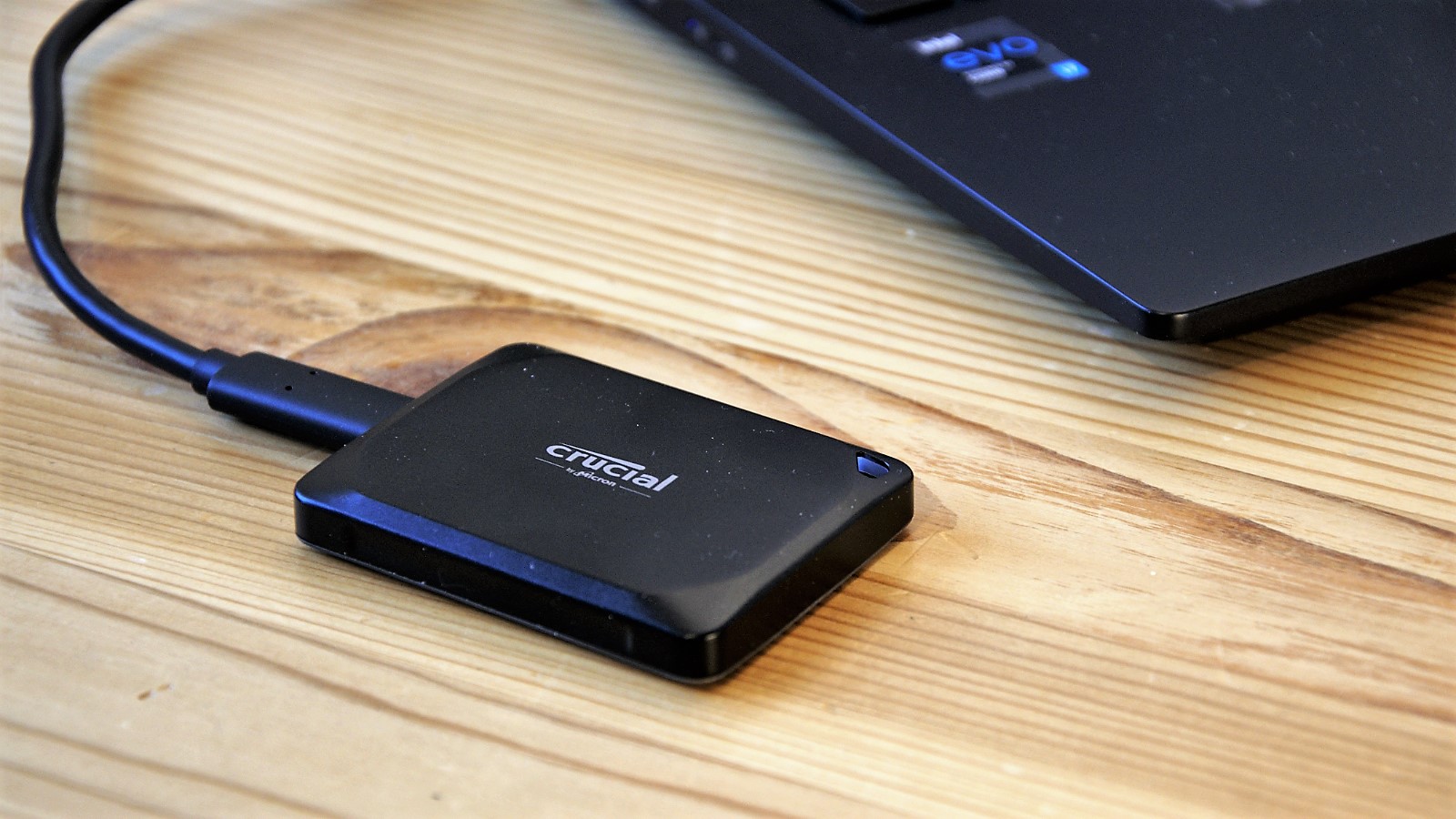
Crucial X10 Pro: Specs
| Model No.: | CT2000X10PROSSD9 | Row 0 - Cell 2 |
| Capacities: | 4TB/2TB/1TB | Row 1 - Cell 2 |
| Capacity tested: | 2TB | Row 2 - Cell 2 |
| Tested sequential performance (Read/Write): | 2057/1834 MB/s | Row 3 - Cell 2 |
| Connection: | USB 3.2 Gen 2 using Type-C | Row 4 - Cell 2 |
| Encryption: | Hardware | Row 5 - Cell 2 |
| Dimensions: | 65 x 50 x 10mm (WxHxD) | Row 6 - Cell 2 |
| Weight: | 38g | Row 7 - Cell 2 |
| Warranty: | 5 years | Row 8 - Cell 2 |
Crucial X10 Pro: Design
- X6 Evolved
- Only USB-C
- IP rated
The size of the X9 Pro and X10 Pro, is much closer to the X6 in scale than the original X8, and it may have been the designer's starting point for this new generation.
When placed alongside the X6, the X10 Pro is almost the same width across but much shorter and thinner.
Where the X8 used M.2 2280 sized NVMe drives in its enclosure, and the X9 Pro and 10 Pro are probably built around M.2 2230 form factor modules, is our best guess. But the engineers at Crucial have also gone much further in making this 65 x 50 x 10mm (WxHxD) enclosure seem much more solid and able to take more abuse.
The top feels like a solid block of aluminium milled to make room inside for the SSD, whereas the underside is a rubberised TPU finish that stops it from sliding around.
The styling and finish are a distinct improvement from the X8 and X6, although a rather curious feature is in the top right corner.
Initially, this hole looks designed to hang the drive on a belt or lanyard, and indeed, the hole goes all the way through. However, in testing, I discovered that Crucial placed the activity LED in this pocket, even if you can only see it from acute angles.
The hole needed a more significant slope on the side with the LED for this to work as intended more often than it does.
One disappointment in the X10 Pro package is that Crucial only includes the USB-C cable, and at 23 cm, it’s a relatively short one. While this is the same as the X6, the X8 always came with a USB-A adapter. When you consider that for the 4TB models, some customers will be paying nearly $480 for the privilege of owning one, that they couldn’t include an adapter which would cost them less than a dollar seems remarkably avaricious.
Where this design has improved over its predecessors is how far the enclosure goes to protect the contents. In comparison, the X8 and X6 did offer a robust construction but weren’t rated for any degree of abuse or environmental assault.
The X10 Pro is IP55 rated against dust and water ingress, though that doesn’t extend to taking it swimming, just light rain. It is also specified to withstand a drop of 2M, but only on a carpeted floor, not concrete. Most drives can handle falling that distance onto a carpet, surely?
The stronger clue that the X10 Pro, and by association the X9 Pro, can handle more abuse than the X8 and X6 is that those drives only came with a 3-year warranty, whereas the new designs get a 5-year limited coverage.
- Design: 4 / 5
Software
- Software trials
- Acronis True Image
- MIA Hedge
On initial inspection, the X10 Pro seems to come with plenty of software, even if none of that is on the drive, and it all must be downloaded.
Two inclusions, Adobe’s Creative Cloud All-apps plan and Mylio Photos, are month-long trials aimed at getting customers to sign up for expensive tools they may or may not use. A month’s access to the Creative Cloud All-apps plan is worth 51.98 ($54.99), which you might save if you want to start using this facility.
What is free is the Crucial Storage Executive, a utility designed to manage and maintain SSDs. This tool has been updated since the X10 Pro launched and now recognises it, and even offered a firmware update for this device when we ran it.
Owners can also access a Crucial branded version of Acronis True Image, which is very useful for cloning systems for an internal SSD upgrade using the external SSD.
What is less useful is a link on the drive that supposedly takes you to a Crucial branded version of Hedge, a commercial live backup tool. At this time, the link takes you to the X10 Pro support page, where no further mention is made of Hedge.
Hopefully, at some point, it will appear and work with the X10 Pro, as backing up a laptop or desktop system is a use this drive is suitable for.
- Software: 3 / 5
Crucial X10 Pro: Performance
- Great performance
- Hardware encryption
| Header Cell - Column 0 | Read (MBps) | Write (MBps) |
|---|---|---|
| AJA | 1882 | 1617 |
| CrystalDiskMark Default | 2057 | 1834 |
| CrystalDiskMark Real World | 1645 | 1688 |
| ATTO | 1920 | 1720 |
| AS SSD | 1875 | 1304 |
All our testing was done using a 2TB X10 Pro provided by Crucial, and according to its information, no significant speed difference exists between this capacity and the other X10 Pro models.
Crucial quotes a speed of 2,100MB/s reads and 2,000MB/s writes for this drive, almost twice that of the X9 Pro and X8, which only have Gen 2 interfaces.
Using the default profile of CrystalDiskMark, we managed reads of 2057MB/s and writes of 1834MB/s, near enough to be respectable. Using the real-world profile on this benchmark, scores dropped to 1645Mb/s reads and 1688MB/s writes, predictably.
While it doesn’t achieve the headline numbers, these results are at the top end of realistic expectations for Gen 2x2 attached drives, above Gen 2 but below what a Thunderbolt connected SSD can achieve.
Taking all the benchmarks as a whole, the X10 Pro is very comparable to the Kingston XS2000 at the very top end of those that support Gen 2x2 mode.
What is especially good about the X10 Pro is that it can sustain its performance with large files and doesn’t exhibit any thermal throttling issues we’ve seen on other products. That makes it suitable for video file backups and other large data transfers.
That the drive also supports hardware encryption is also a bonus, as many of the cheaper drives do not.
If you have a system with Gen 2x2 ports, then the X10 Pro makes good sense from a performance perspective.
- Performance: 4.5 / 5

Verdict
In the recent crop of USB Gen 2x2 embracing portable SSDs, the X10 Pro is probably the most elegant design with the best specification and quoted durability.
As the flagship in the next generation of X-Series design, the X10 Pro follows in the highly respected footsteps of the X6 and the X8. But those prior products became shorthand for affordability and value for money, whereas the X10 Pro isn’t.
Not only is the pricing of the X8 and X6 a problem for the X10 Pro, but its sibling, the X9 Pro, is yet another.
The X9 Pro has all the same construction, hardware encryption and resilience. It lacks the Gen 2x2 connectivity, but critically, it costs around 33% less for the same capacities. Unless you have only machines with USB 3.2 Gen 2x2 ports, the X9 Pro is a patently better choice.
And, if you don’t need hardware encryption, the X8 and X6 are still solid products with good performance over the commonly found USB 3.2 Gen 2 port.
Should I buy the Crucial X10 Pro
| Value | Expensive even by the standards of Thunderbolt SSDs | 3 / 5 |
| Design | Elegant design but with a curious activity LED placement | 4 / 5 |
| Software | Some trials, some useful software and some missing in action | 3 / 5 |
| Performance | Great performance over the short and long haul, and doesn’t have thermal throttling issues. But you need Gen 2x2 to get the most out of it. | 4.5 / 5 |
| Overall | Beautifully made and a good performer, the X10 Pro is only let down by missing software and awkward pricing | 4 / 5 |
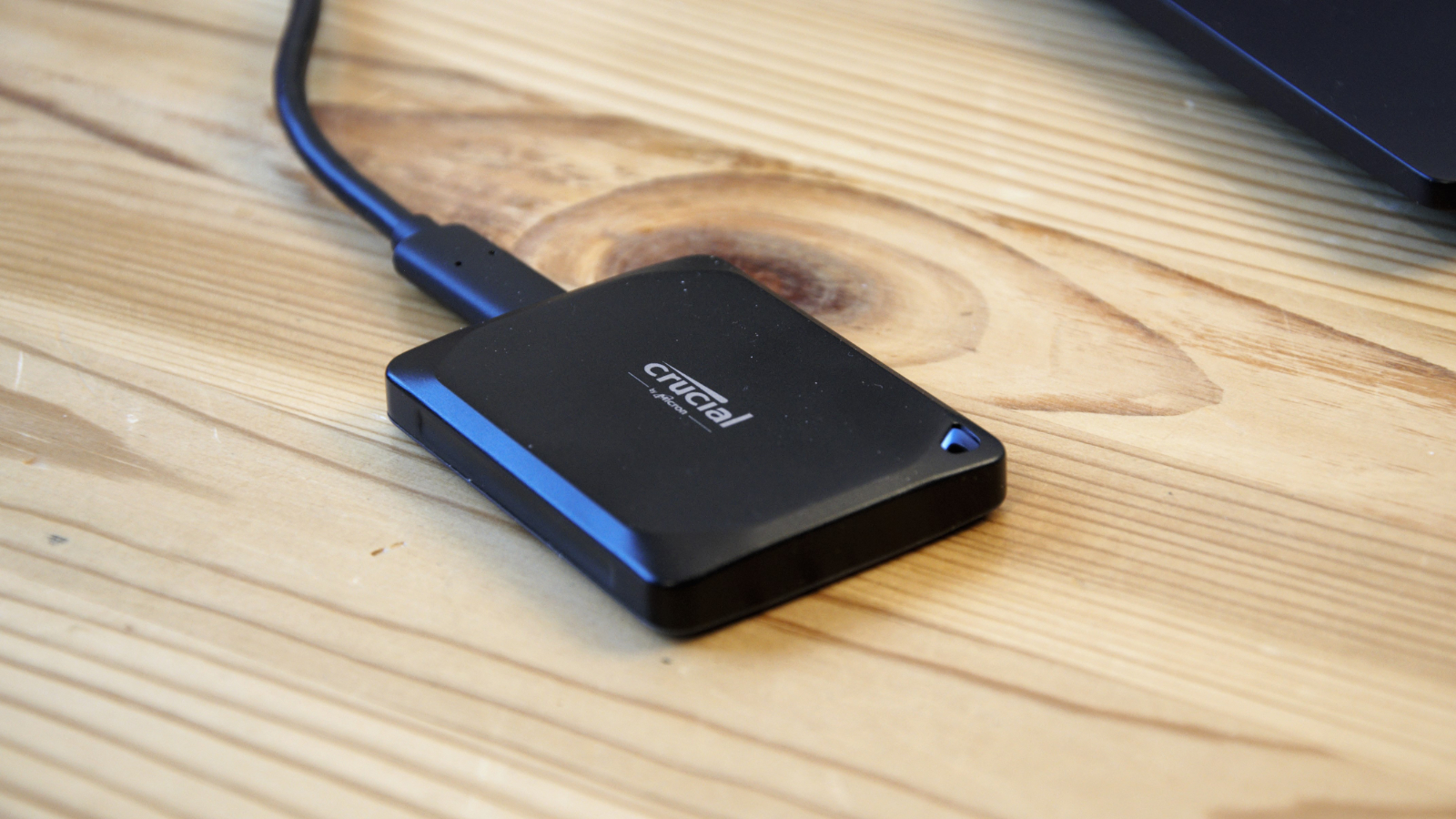
Buy it if...
You have USB 3.2 Gen 2x2 ports
There are many alternative designs that are cheaper, offer encryption and come in larger capacities if you don’t need Gen 2x2 performance. This drive will work with the slower USB ports, but you might as well save some money and buy a cheaper one in that case.
You copy big files
One of the quickest Gen 2x2 drives we’ve tested, it can sustain read and write performance over the long haul effectively. But, you can go faster with Thunderbolt.
Don't buy it if...
Only need space
For those that don’t have Gen 2x2 USB ports and have no use for encryption, other options, like the X6 and X8, are far more cost-effective options than the X10 Pro. Soon USB 4.0 compatible devices are likely to appear, which will make the X10 Pro seem slow in comparison.
You need more than 4TB
It’s slightly disappointing that the maximum size on offer is only 4TB since the X8 offered that some time ago. There are some external SSDs that offer 8TB, and with the scale of NAND modules increasing, it is likely that we’ll see more big-capacity drives soon.
Also consider
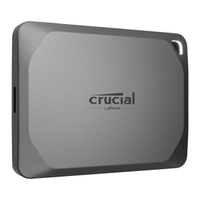
Crucial X9 Pro
Physically identical to the X10 Pro except in silver. The X9 Pro has the same resilience and waterproofing and comes in the same capacities. But it only supports Gen 2 USB connections, reducing the speed to 1000MB/s
For the slower speeds, the price is significantly reduced over the X10 Pro, and it still offers hardware encryption.
Kingston XS2000
This drive came out in late 2021, when Gen 2x2 drives weren’t a popular option.
While it does use a plastic construction, it does achieve an IP55 rating and should travel well enough. Costing more than the Nano V2, the extra expense delivers better-sustained performance and hardware encryption. And, it might be worth it.
Check out our Kingston XS2000 review
We've covered all the best external SSDs here for you
Mark is an expert on 3D printers, drones and phones. He also covers storage, including SSDs, NAS drives and portable hard drives. He started writing in 1986 and has contributed to MicroMart, PC Format, 3D World, among others.
